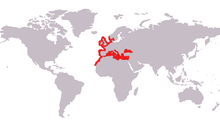European seabass
| European bass | |
|---|---|
 |
|
| Scientific classification | |
| Kingdom: | Animalia |
| Phylum: | Chordata |
| Class: | Actinopterygii |
| Order: | Perciformes |
| Suborder: | Percoidei |
| Family: | Moronidae |
| Genus: | Dicentrarchus |
| Species: | D. labrax |
| Binomial name | |
|
Dicentrarchus labrax (Linnaeus, 1758) |
|
 |
|
| Synonyms | |
|
click to expand
|
|
The European seabass (Dicentrarchus labrax) is a primarily ocean-going fish that sometimes enters brackish and fresh waters. It is also known as the sea dace. Highly regarded as a table fish, it is often marketed as Mediterranean seabass, loup de mer, robalo, lubina, spigola, branzino, or bronzino.
Debate has been ferocious in Britain in recent years as to the origin of the word "seabass". The traditional word was "bass", but that has changed with the recent popularity of cooking programmes and the expansion of restaurant marketing, both of which have adopted the phrase "seabass". Only one type of bass is found in the British Isles, thus the expression "seabass" is probably unnecessary, although the largemouth (or black) bass indigenous to North America has been widely stocked in Southern Europe with significant breeding populations in many lakes and rivers in southwestern France. Thus, the distinction is valid in a European context.
The European bass is a member of the Moronidae family. The name Dicentrarchus derives from the presence of two anal spines ("di" = two, "kentron" = sting, "archos" = behind, anus), although there may be even three. It has silver sides and a white belly. Juvenile fish maintain black spots on the back and sides, a feature that can create confusion with Dicentrarchus punctatus. This fish's operculum is serrated and spined. It can grow to a total length over 1 m (3.3 ft) and 15 kg of weight.
Branzino is the name of the fish in Northern Italy, with branzini as the plural; in other parts of Italy, it is called spigola or ragno. In Spain, where it is farmed, the fish is called lubina or róbalo. In Portugal, it is called robalo. In France, the fish is called bar commun along the Atlantic coast and loup de mer on the Mediterranean. It is called llobarro in Catalonia. The Turks refer to the fish as levrek. The countries of former Yugoslavia use a name similar to that used by their Italian neighbors across the Adriatic, the brancin. In Greek, the vernacular name of this fish (as well as that of the related Dicentrarchus punctatus) is lavraki (λαβράκι). In Greek cuisine, the fish can be prepared in a variety of ways (e.g. grilled, steamed in parchment) and is often considered a delicacy. Greek journalists use the same word (lavraki) to refer to high-value exclusive news stories, a cultural reference to the perceived luck of an angler who catches this fish.
...
Wikipedia

